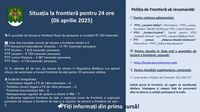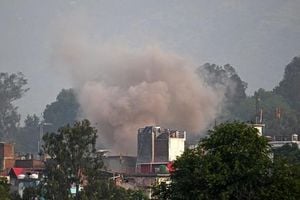In the past 24 hours, border authorities in Moldova have reported a significant influx of travelers, with a total of 57,353 crossings recorded at various border points. This surge comes as the country continues to manage its border security amid rising international travel. According to the Border Police of Moldova, the busiest entry point remains Chisinau International Airport, which alone accounted for 13,701 crossings. Other notable border crossing points included Sculeni with 7,815 crossings, Leuseni with 8,729, Palanca with 4,387, and Otaci with 4,115 crossings.
However, this busy period also saw a strict enforcement of entry regulations, leading to the denial of entry for 30 foreign citizens attempting to enter Moldova. The authorities reported various violations, including four illegal border crossings, two instances of using false documents, and seven cases of non-compliance with the rules governing entry and stay in the country. Additionally, there were three violations related to the state border regime and the rules for crossing the border.
In an effort to manage congestion at border points, the Border Police have recommended alternative routes for travelers. For instance, those using the Leușeni-Albița crossing are advised to consider the Leova-Bumbăta or Cahul-Oancea crossings during peak hours. Similarly, travelers at the Sculeni-Sculeni border point are encouraged to use the Costești-Stânca or Lipcani-Rădăuți Prut crossings. For the Palanca-Maiaki-Udobnoe crossing, the Tudora-Starokazacie point is suggested as an alternative.
For real-time updates on border crossing points, the public can visit the official website of the Border Police at border.gov.md/camere-web. Additionally, inquiries can be directed to the Border Police's dedicated hotline at 022 259 717.
Meanwhile, Romania's border police reported processing approximately 71,800 individuals and over 15,300 vehicles at its external borders on April 6, 2025. This included 35,720 entries into Romania, with 7,915 vehicles crossing the border. Notably, since February 10, 2022, a staggering 11,409,443 Ukrainian citizens have entered Romania, reflecting the ongoing movement of people amid regional tensions.
As part of a broader strategy to streamline border management, Romania eliminated border controls at its internal borders with Hungary and Bulgaria starting January 1, 2025. This change allows travelers to move freely between these countries without stopping for document checks at police checkpoints. However, Romanian border police retain the right to conduct random checks within a 30-kilometer zone from the border to ensure compliance with legal requirements.
In the last 24 hours, Romanian authorities conducted over 10,700 checks using the eDAC application, which connects to relevant databases for real-time verification. These checks have led to the identification of 103 illegal acts, comprising 32 crimes and 71 offenses. Fines totaling 41,646 lei were imposed, and goods worth approximately 852,700 lei were seized to protect consumers from illegal trade.
Additionally, 34 foreign citizens were denied entry into Romania on April 6, 2025, for failing to meet legal entry requirements, while five Romanian citizens were not permitted to leave the country for various legal reasons.
Romanian border police are committed to maintaining security and facilitating the movement of legitimate travelers while actively combating illegal activities. They emphasize their readiness to assist citizens in any situation, ensuring that border crossings remain as smooth and efficient as possible.
As travel continues to increase, both Moldova and Romania are adapting their border management strategies to address the challenges posed by high volumes of crossings while ensuring compliance with legal standards. The focus remains on balancing security with the facilitation of legitimate travel, reflecting broader trends in regional border management.






